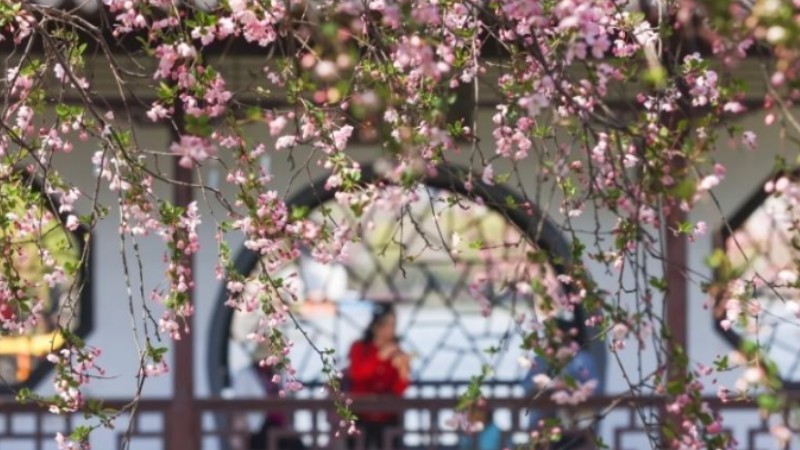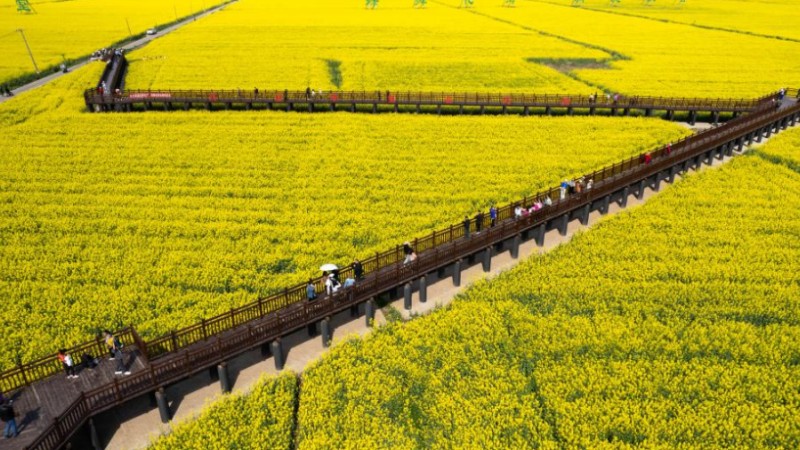Nation sheds more light on its rich past (3)
The Huangshicheng complex near the Forbidden City took two years to complete. JIANG DONG/CHINA DAILY
Rich legacies
In Huangshicheng's main palace, the most important archival material was placed in large golden cabinets known as jingui, with each one weighing 166 kilograms. The interiors of the cabinets were made from nanmu, a precious mothproof wood, and the exteriors — which featured engraved patterns of dragons and clouds — from a mixture of gold and copper.
A total of 152 jingui still exist, of which 19 were made during the Ming Dynasty and the remainder in the Qing Dynasty. Some of them are on display, with about 30 retained in the main palace, and the rest stored at the First Historical Archives of China for better protection, Wu said.
"The cabinets were made in different times. Although they follow the same format, there are differences in the detailed craftsmanship. Some have more exquisite patterns, while others were made in a relatively perfunctory way," he said.
Wu described how Huangshicheng functioned in the past. When an emperor died, his successor started to organize government officials to compile shilu ("veritable records"), chronicles of major events during the reign of the late emperor, and also to gather his important sayings to form another collection called shengxun ("the imperial sermon").
After a ceremony in the Forbidden City, shilu and shengxun were sent to Huangshicheng, where they were placed in the cabinets. Copies of them were sent to the Imperial Palace in Shengjing (present-day Shenyang, Liaoning province). The imperial palace of the early Qing emperors was regarded as their home.
Drawings of how the golden cabinets were arranged remain to this day.
After Huangshicheng was built, Emperor Jiajing ordered 109 people to make a copy of Yongle Dadian, the world's largest general encyclopedia made from paper in ancient times, which was commissioned by Emperor Yongle (1360-1424) in 1403.
It took five years to complete this work. The duplicate was stored at Huangshicheng for more than 160 years, before being moved to Hanlinyuan, the imperial academy during the reign of Emperor Yongzheng (1722-35). The original collection has been lost, and the volumes that remain are part of the duplicated versions.
According to records from the time of Emperor Qianlong (1711-99), 19 people worked at Huangshicheng. They guarded the site and placed the documents in the sun in spring and autumn to better preserve them.
Unlike modern archives, where records can be accessed by the public, those stored at Huangshicheng were seldom borrowed unless permission was granted by the emperor. They remained in the cabinets most of the time.
Wu said, "At a time when there were no modern facilities such as air-conditioners, the construction of Huangshicheng shows that the best possible measures were taken to protect the archives from fire and damp, and keep the temperature at which they were stored constant."
The main palace is constructed on a platform 1.4 meters above the ground, with the cabinets placed on another platform the same height above the platform, making it difficult for rainwater to reach them.
The main palace was also built with extremely thick walls.
"The south wall is more than 6 meters wide, the north wall exceeds 5 meters, and the east and west walls are both 3.7 meters wide. The walls ensure the palace remains warm in winter and cool in summer," Wu said.
 |  |
Photos
Related Stories
- Study reveals sustainable agriculture in north China 5,500 yrs ago
- An animated trip through history across the Yangtze River
- Senior CPC official stresses forging brighter future while remembering history
- China urges Japan to reflect on aggression history
- Whistling arrow in Tibet soars through history
- Tracing the footsteps of the CPC over past century
- China continues to promote Party history learning
- Chinese envoy calls for multilateralism on anniversary of end of WWII in Europe
- China remembers September 18 Incident
- Scientists work to uncover the story behind a legendary sword
Copyright © 2023 People's Daily Online. All Rights Reserved.










